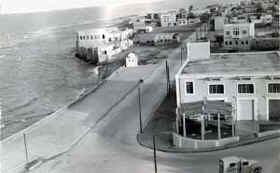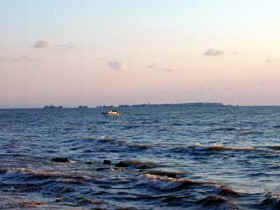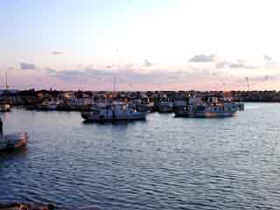|

The city of
Tartous is located on the eastern coast of the Mediterranean, 258 km to
the northwest of the Syrian capital Damascus and 30 km to the North of the
Lebanese border.
Tartous' origins are Phoenicians,
although it has been occupied and controlled by different successive
civilizations. During the European crusades, Tartous reached its'
heydays as a military post and a port for provisions. Later on, the
control of the city was surrendered to the Byzantines, the Arabs and the
Turks.

This picture
was taken in 1952 from the minaret of the mosque of Al-Baladieh, showing
El-Mina St. Although bustling with activity, this part of the city never
lost its' charm.
The city
extends over 1600 hectares of land and is home to 88,533 people. The
Tartous harbor is the 2nd major one in Syria and is the key source of
income for the city. The island of Arwad is 3 km to the southwest.
There's a small fishing port from which tourists and visitors could put
out to sea to the only inhabited island in Syria. Right adjacent to the
beach is the old city which is surrounded by 3 protection walls. Within,
people live amid ancient monuments dating back to successive
civilizations. A crusader church, a meeting hall for the crusader knights,
underground tunnels, Arabian baths and a large cathedral (today it serves
as a public museum) still testify to the glorious history of this ancient
city. Around this old city center, modern Tartous expands to the North,
East and South in a seasoned mixture of old and new.

The island of Arwad
as seen from the seafront of Tartous
There are 13 Muhafazats (Provinces)
in Syria. Tartous is the center of one of these. The total area of the
province is 1892 kmē and it has a population of 666,000 people. Best
known for its' fertile land, the province produces olives and olive oil of
world renowned quality. Castles, citadels and ruins from ancient times are
dispersed throughout the land. When driving through the winding mountain
roads of the province, one gets the sensation of driving through history.

Headquarters
for the old city restoration project, this historic building is part of
the wall surrounding the ancient city
Mansour Architect is involved in an
ambitious project for the restoration of the old city. After the signing
of an international protocol of coordination between the city of Tartous
on one side and the Spanish cities of Alicante and Palma de Mallorca on
the other, Mansour Architect was appointed as a private consultant by the
Spanish of cities of Alicante and Palma de Mallorca and it performs its' duties as part of the technical team formed by
the 3 cities to undergo the restoration process.

The Tahoon (Windmill
port )
The most important asset is the
Tartousians themselves. They are extremely nice folks, very easy to get
along with, and as most seafarers, hard working and adventurous.

Back
to Top Home
|
